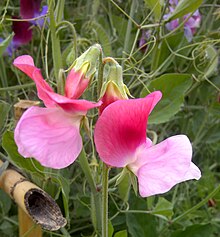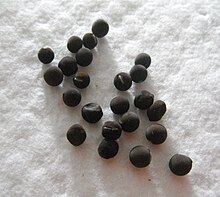
Tropaeolum, commonly known as nasturtium, is a genus of roughly 80 species of annual and perennial herbaceous flowering plants. It was named by Carl Linnaeus in his book Species Plantarum, and is the only genus in the family Tropaeolaceae. The nasturtiums received their common name because they produce an oil similar to that of watercress.
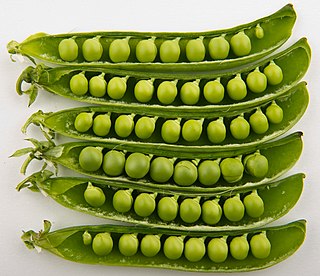
Pea is a pulse, vegetable or fodder crop, but the word often refers to the seed or sometimes the pod of this flowering plant species, formerly 'Pisum sativum', it has been proposed to rename the species as Lathyrus oleraceus. Each pod contains several seeds (peas), which can have green or yellow cotyledons when mature. Botanically, pea pods are fruit, since they contain seeds and develop from the ovary of a (pea) flower. The name is also used to describe other edible seeds from the Fabaceae such as the pigeon pea, the cowpea, the seeds from several species of Lathyrus and is used as a compound form for example Sturt's desert pea.
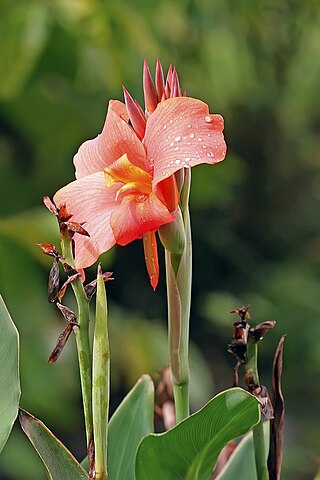
Canna or canna lily is the only genus of flowering plants in the family Cannaceae, consisting of 10 species. All of the genus's species are native to the American tropics and naturalized in Europe, India and Africa in the 1860s. Although they grow native to the tropics, most cultivars have been developed in temperate climates and are easy to grow in most countries of the world, as long as they receive at least 6–8 hours average sunlight during the summer, and are moved to a warm location for the winter. See the Canna cultivar gallery for photographs of Canna cultivars.
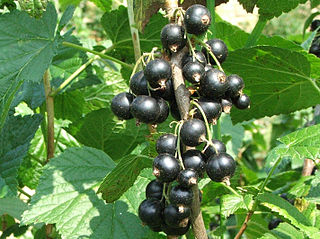
The blackcurrant, also known as black currant or cassis, is a deciduous shrub in the family Grossulariaceae grown for its edible berries. It is native to temperate parts of central and northern Europe and northern Asia, where it prefers damp fertile soils. It is widely cultivated both commercially and domestically.

Lathyrus is a genus of flowering plants in the legume family Fabaceae, and contains approximately 160 species. Commonly known as peavines or vetchlings, they are native to temperate areas, with a breakdown of 52 species in Europe, 30 species in North America, 78 in Asia, 24 in tropical East Africa, and 24 in temperate South America. There are annual and perennial species which may be climbing or bushy. This genus has numerous sections, including Orobus, which was once a separate genus. The genus has numerous synonyms, including Pisum, the ancient Latin name for the pea.

Pelargonium is a genus of flowering plants that includes about 280 species of perennials, succulents, and shrubs, commonly called geraniums, pelargoniums, or storksbills. Geranium is also the botanical name and common name of a separate genus of related plants, also known as cranesbills. Both genera belong to the family Geraniaceae. Carl Linnaeus originally included all the species in one genus, Geranium, and they were later separated into two genera by Charles Louis L'Héritier de Brutelle in 1789.

Lathyrus latifolius, the perennial peavine, perennial pea, broad-leaved everlasting-pea, or just everlasting pea, is a robust, sprawling herbaceous perennial flowering plant in the pea family Fabaceae. It is native to Europe but is present on other continents, such as North America and Australia, where it is most often seen along roadsides.

Lathyrus sativus, also known as grass pea, cicerchia, blue sweet pea, chickling pea, chickling vetch, Indian pea, white pea and white vetch, is a legume commonly grown for human consumption and livestock feed in Asia and East Africa. It is a particularly important crop in areas that are prone to drought and famine, and is thought of as an 'insurance crop' as it produces reliable yields when all other crops fail. The seeds contain a neurotoxin that causes lathyrism, a neurodegenerative disease, if eaten as a primary protein source for a prolonged period.
Neurolathyrism, is a neurological disease of humans, caused by eating certain legumes of the genus Lathyrus. This disease is mainly associated with the consumption of Lathyrus sativus and to a lesser degree with Lathyrus cicera, Lathyrus ochrus and Lathyrus clymenum containing the toxin ODAP.
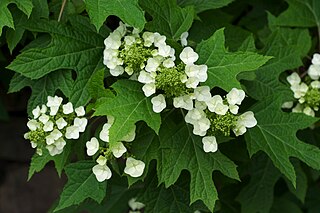
Hydrangea quercifolia, commonly known as oakleaf hydrangea or oak-leaved hydrangea, is a species of flowering plant in the family Hydrangeaceae. It is native to the southeastern United States, in woodland habitats from North Carolina west to Tennessee, and south to Florida and Louisiana. A deciduous shrub with white showy flower heads, it is grown as a garden plant, with numerous cultivars available commercially.
Osteolathyrism, sometimes referred to as odoratism, is a form of the disease Lathyrism. The disease results from the ingestion of Lathyrus odoratus seeds. The toxin found in the sweet peas is (beta-aminopropionitrile), which affects the linking of collagen, a protein of connective tissues. The condition results in damage to bone and mesenchymal connective tissues. Osteolathyrism occurs in people in combination with neurolathyrism and angiolathyrism in areas where famine demands reliance on a crop with known detrimental effects. It occurs in cattle and horses with diets overreliant upon the grass pea. Prominent symptoms include skeletal deformities and bone pain.
Henry Eckford was a Scots horticulturist and reputedly the most famous breeder of sweet peas, transforming the plant from a minor horticultural subject into the queen of annuals. U.S. horticulturist Liberty Hyde Bailey called him "the prince of specialists". In 1888 he moved to the town of Wem in Shropshire, England. It was in Wem that he perfected the breeding of his Grandiflora sweet peas, which in size of bloom and general performance were a great improvement over previous varieties.

Lathyrus niger, also known as black pea, blackening flat pea and black bitter vetch, is a perennial legume that is native to Europe. Its common name is reference to the blackening of the plant's foliage as it dies.
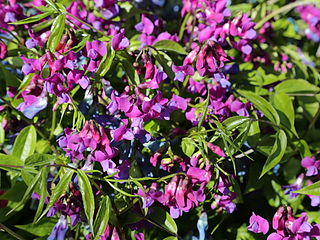
Lathyrus vernus, the spring vetchling, spring pea, or spring vetch, is a species of flowering herbaceous perennial plant in the genus Lathyrus, native to forests of Europe and Siberia. It forms a dense clump of pointed leaves with purple flowers in spring, shading to a greenish-blue with age.

Lathyrus belinensis, also known as the Belin pea is a flowering plant species in the genus Lathyrus under the family Fabaceae. The species was discovered in Turkey by botanists Nigel Maxted and David John Goyder and was first described in 1988. The species is a highly localized endemic found only in the Turkish province of Antalya. L. belinensis was listed among the top one hundred most endangered species of the world by the IUCN in 2012.
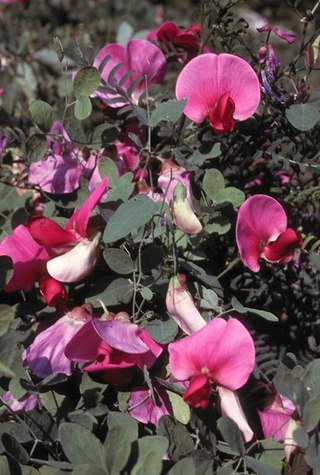
Lathyrus grandiflorus, two-flowered everlasting pea, is a species of flowering plant in the family Fabaceae, native to southern Europe. Growing to 2 m (6.6 ft) tall, it is a twining herbaceous perennial with grey-green leaves and, in late summer, bright magenta-pink flowers, the central keel a darker red. Unlike its cousin, the annual sweet pea, it is unscented. Once established it is a robust plant with the ability to scramble into other shrubs and trees. It is very hardy, down to −20 °C (−4 °F), so is capable of surviving conditions in most temperate regions of the world.

Wisteria brachybotrys, the silky wisteria, is a species of flowering plant in the pea family Fabaceae from Japan. Some older references believed it to be of garden origin. It is certainly very widely cultivated in its native Japan, with the white flowered cultivars more widely grown than the pale violet cultivars. It is in fact native to western parts of Honshu and throughout Shikoku and Kyushu, growing in mountain forests and woods from 100 to 900m. It is not at all clear why it is less popular in the west than in Japan.
Lathyrism is a condition caused by eating certain legumes of the genus Lathyrus. There are three types of lathyrism: neurolathyrism, osteolathyrism, and angiolathyrism, all of which are incurable, differing in their symptoms and in the body tissues affected.
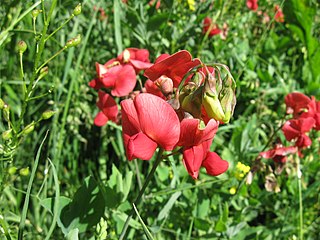
Lathyrus rotundifolius, the Persian everlasting pea, is a species of flowering plant in the pea family Fabaceae, native to Turkey. Growing to 1.5 m (4.9 ft) tall, this herbaceous perennial climber has twining, clinging tendrils and brick red flowers in summer. Unlike its relative, the sweet pea, the flowers are unscented. It is hardy to −20 °C (−4 °F), but requires a position in full sun.
